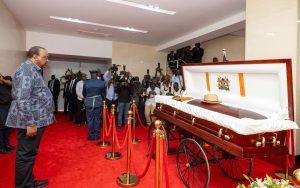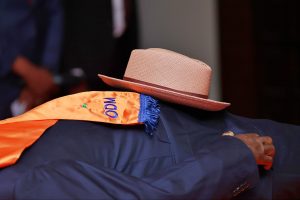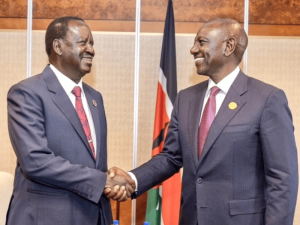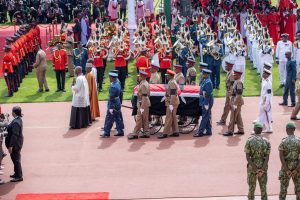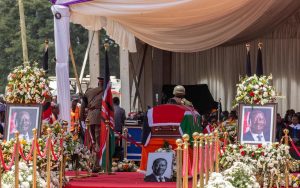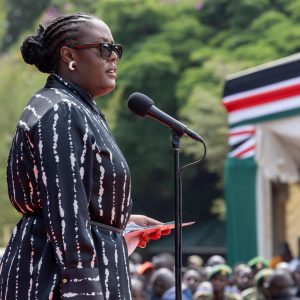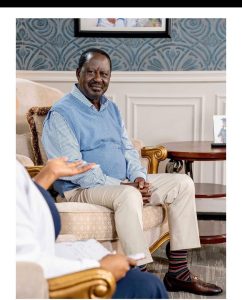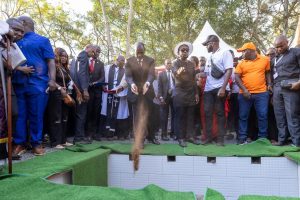Opinion
The Curtain Falls on Raila Odinga: Marking The End Of An Era of Kenya’s Most Consequential Political Leader in History
Throughout his career, Raila demonstrated an almost supernatural ability to survive political obituaries.
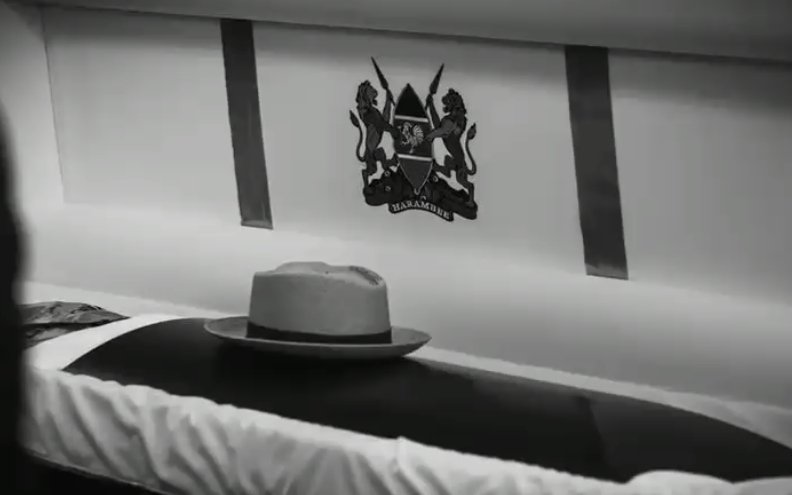
The silence that descended over Kang’o ka Jaramogi on that Sunday evening was profound. As the seventeenth gunshot echoed across the ancestral homestead in Bondo, followed by the roar of military aircraft overhead, Kenya bid farewell to a man who had defined its political landscape for over four decades without ever occupying its highest office.
Raila Amolo Odinga, who died on October 15, 2025, while receiving treatment in India at the age of 80, was laid to rest beside his father Jaramogi Oginga Odinga, Kenya’s first Vice President, completing a story that began with independence and ended with a nation transformed.
The funeral itself was a study in contrasts and contradictions, much like the man it honored. Here was the state he had fought, challenged, and occasionally partnered with, according him full military honors.
The same government that had once imprisoned him without trial for six years now draped his coffin in the national flag and positioned soldiers in crisp formation to salute his departure.
President William Ruto, who had defeated him in the 2022 presidential election, led the mourners and openly acknowledged Raila as his political mentor.
Former President Uhuru Kenyatta, once his bitter rival before their famous 2018 handshake, eulogized him as a close friend and statesman.
The irony was not lost on the thousands who had gathered at the Jaramogi Oginga Odinga University of Science and Technology grounds to witness history.
What made Raila Odinga so consequential was not what he achieved in formal office, though his tenure as Prime Minister in the Grand Coalition Government from 2008 to 2013 saw significant infrastructure development and reform initiatives.
Rather, it was his ability to shape Kenya’s political destiny from outside the presidency that cemented his place in history. He was, as President Ruto aptly described him, a man who ruled without the instruments of power.
His fingerprints are visible on nearly every major chapter of Kenya’s modern political evolution, from the multiparty democracy struggles of the early 1990s to the promulgation of the 2010 Constitution that restructured governance and introduced devolution.
Born on January 7, 1945, in Maseno to a family already steeped in nationalist politics, Raila inherited both privilege and burden.
His father Jaramogi had been a fierce ally of Jomo Kenyatta in the independence struggle but fell out with Kenya’s founding president over ideological differences, particularly regarding land distribution and the treatment of opposition voices.
This schism would define the Odinga family’s relationship with power for generations. Where Jaramogi represented the old guard of African nationalism with its pan-African socialist ideals, Raila would become something more complex and contemporary: a democrat, a reformer, a coalition builder, and a master of political theater.
His political awakening came through suffering. After studying engineering in East Germany and returning to lecture at the University of Nairobi, Raila’s trajectory changed dramatically in 1982. Following the failed coup attempt against President Daniel arap Moi’s regime, he was detained without trial for six years, accused of treason though never charged.
The years in Kamiti Prison and later in the notorious Nyayo House cells transformed him. He emerged not broken but hardened, with nothing to lose and everything to fight for. As he would later write in his autobiography, “You can imprison a man’s body, but not his ideas.”
The 1990s saw Raila at the forefront of the second liberation struggle, the movement that broke the one-party stranglehold of KANU and paved the way for multiparty democracy. Alongside veterans like Kenneth Matiba and Charles Rubia, he risked everything to demand political pluralism. It was a dangerous era to challenge Moi, but Raila’s voice only grew louder.
In 1992, he won his first parliamentary seat representing Lang’ata Constituency, beginning a legislative career that would span decades and establish him as one of the most effective opposition leaders in African politics.
Yet it was in 2002 that Raila demonstrated his most audacious political skill: the ability to sacrifice personal ambition for a larger strategic goal. His declaration of “Kibaki Tosha” during that year’s presidential campaign, endorsing Mwai Kibaki and uniting the opposition under the National Rainbow Coalition, engineered the defeat of KANU’s 39-year grip on power.
It was a political masterstroke that elevated him from opposition agitator to national kingmaker.
The fact that he was subsequently betrayed by the Kibaki administration, which reneged on a pre-election memorandum of understanding promising him the prime minister’s position, only added to his mythology as a leader repeatedly denied what was rightfully his.
The disputed 2007 presidential election and its aftermath remain the most controversial chapter in Raila’s political journey. The violence that erupted, claiming over 1,000 lives and displacing more than 600,000 people, exposed the fragility of Kenya’s democracy and the depth of its ethnic divisions. Yet even in this national trauma, Raila found a path to redemption.
The power-sharing agreement brokered by former UN Secretary-General Kofi Annan, which created the position of Prime Minister for him, allowed Kenya to step back from the brink. His tenure in that office, alongside President Kibaki in the Grand Coalition Government, demonstrated that he could govern responsibly and deliver tangible results.
Perhaps his most enduring contribution to Kenya was his relentless advocacy for constitutional reform. The 2010 Constitution, which fundamentally restructured how Kenya is governed, bears his imprint more than any other political leader of his generation. The devolution of power and resources to county governments, the strengthened Bill of Rights, the creation of independent commissions to check executive power, these were reforms Raila had championed for decades.
As Kisumu Governor Anyang’ Nyong’o noted at the funeral, without Raila, Kenya might not have realized the transformative constitution it now enjoys.
His subsequent presidential campaigns in 2013, 2017, and 2022 all ended in defeat, though his supporters consistently claimed electoral manipulation. The 2017 election was particularly dramatic.
After the Supreme Court nullified the initial results and ordered a fresh poll, which he boycotted, Raila participated in a mock swearing-in ceremony as the “People’s President” at Uhuru Park. It was a moment of maximum tension, with the nation teetering on the edge of another crisis.
Yet within months, he would stun the country again by shaking hands with President Kenyatta on the steps of Harambee House, initiating the famous handshake that would redefine his final years.
The handshake marked Raila’s evolution from perpetual opposition leader to elder statesman. The Building Bridges Initiative that followed, though ultimately struck down by the courts, represented his vision of a more inclusive political system.
His subsequent engagement with the William Ruto administration, which saw ODM members join a broad-based government in 2024, was controversial among his supporters but consistent with his belief in dialogue over confrontation.
As former Nigerian President Olusegun Obasanjo observed at the funeral, “Tolerance is a lesson of love. Raila tolerated accommodation.”
What distinguished Raila from other African opposition leaders was his ability to maintain relevance across generations. While many of his contemporaries faded into irrelevance or were consumed by bitterness after electoral defeats, Raila continually reinvented himself.
He built the Orange Democratic Movement into arguably Kenya’s most enduring political party, marking its 20th anniversary just weeks after his death.
He cultivated a fanatical following that transcended ethnic boundaries, though his base remained strongest in Nyanza and parts of coastal Kenya. His nicknames spoke to his multifaceted persona: Enigma, Agwambo (the mysterious one), Tinga, Nyundo (the hammer), Jakom (the chairman), and simply Baba (father).
The Raila brand was built on more than political platforms or policy positions. It was emotional, visceral, rooted in symbols and stories.
His trademark cap, his rolling gait, his finger-wagging speeches, his ability to quote Shakespeare and traditional proverbs in the same breath, his famous laugh, these elements created a political identity that existed somewhere between myth and memory.
When his daughter Winnie carried that iconic cap at Jomo Kenyatta International Airport as his body was returned from India, she was not merely carrying a hat but the weight of an entire political legacy.
Throughout his career, Raila demonstrated an almost supernatural ability to survive political obituaries.
After each electoral defeat, analysts would declare his career finished, only to watch him reemerge stronger. This resilience was rooted in his genuine connection with ordinary Kenyans who saw in him a champion of their aspirations and grievances.
Whether he was crusading against corruption, demanding electoral reforms, or fighting for the rights of the marginalized, Raila positioned himself as the voice of those locked out of power.
His decades-long fight for democracy, human rights, and constitutional reform is well documented and forms the core of his historical legacy.
The state funeral accorded to him, complete with a 17-gun salute and military fly-past, was unprecedented for someone who had never been president. As Siaya Governor James Orengo noted, it was the first such honor for a leader from Nyanza region.
His father Jaramogi, despite serving as Vice President, never received a state funeral.
Tom Mboya and Robert Ouko, other prominent leaders from the region who met tragic ends, were not honored in this manner.
The recognition reflected not just Raila’s individual achievements but also a national acknowledgment of historical injustices and the need for inclusive commemoration of Kenya’s heroes.
Yet even in death, mysteries remained. The 1982 coup that first thrust him into the national spotlight has never been fully explained. Despite promises to write a comprehensive account, Raila took to his grave the full details of his role in that failed attempt to overthrow Moi.
His 2006 biography was vague on the matter, and his 2013 autobiography described his involvement as merely “peripheral.” The question of whether his release from detention without prosecution involved a political deal with Moi remains unanswered. These ambiguities, rather than diminishing his legacy, seemed to enhance the enigma that defined him.
The tributes at his funeral revealed the breadth of his influence. Speaker after speaker, from current leaders to liberation struggle comrades, acknowledged his role in shaping modern Kenya.
Former Speaker Justin Muturi, despite political differences, praised his tenacity and deep love for country. Senior Counsel Paul Muite recalled their shared struggles for justice.
Former Imenti Central MP Gitobu Imanyara spoke of lives that “are lived out loud, with conviction and cost, shaped by purpose and defined by endurance.” Even those who had opposed him politically could not deny the magnitude of his impact.
For the Luo community, Raila’s death represented something beyond the loss of a political leader. He was the custodian of their identity and pride, the embodiment of their long exclusion from the presidency and their determination to remain relevant in national politics. Yet even here, he challenged traditions.
His funeral arrangements, reportedly kept deliberately simple by his wishes, symbolized a break from the often financially ruinous excesses of Luo burial customs.
It was a final statement about values and priorities, about substance over spectacle, even as the state provided the spectacle he had never sought.
The question of succession looms large. ODM has named his elder brother Oburu Odinga as party leader, a gesture toward continuity. But the crowds at his funeral did not chant “Oburu.” They chanted “Baba.” And in the absence of Baba, eyes turned to Winnie Odinga, his daughter, who has emerged as perhaps the most visible keeper of his political flame.
Whether she or anyone else can inherit the Raila brand remains an open question. As Siaya Governor Orengo reminded mourners, “There are those who lead political parties and have abused Raila without knowing that without Raila, they would not be leading those parties.”
What is certain is that Kenya’s political landscape will look profoundly different without Raila Odinga. For over 40 years, he was the constant thread running through every major political development. He set agendas, framed debates, and forced governments to reform even from opposition.
He transformed what it meant to lose elections in Kenya, showing that defeat need not mean political death or descent into violence. He demonstrated that leadership is not confined to formal office, that influence can be exercised through moral authority and popular legitimacy.
History will debate where Raila ranks among Africa’s political giants. He never achieved the continental profile of a Nelson Mandela or a Julius Nyerere.
He did not lead his country to independence or preside over decades of nation-building like Jomo Kenyatta or Julius Kambarage Nyerere. But in the specific context of democratic struggle and constitutional reform in a multiparty era, few African leaders have left a more substantial mark.
He proved that opposition politics could be principled and consequential, that one could challenge power without destroying the state, that reform was possible within the system even when the system seemed designed to resist change.
As the soil covered his coffin at Kang’o ka Jaramogi, next to his father who had died 31 years earlier, the symbolism was complete. Two generations of Odingas, both denied the presidency they arguably deserved, both crucial to Kenya’s political evolution, now rested together.
The son had surpassed the father in impact and reach, had taken the family legacy from regional grievance to national transformation. He had changed Kenya without ever ruling it, had left institutions and freedoms as his monument rather than buildings or statues.
The curtain has fallen on Raila Odinga’s chapter in Kenyan history, but the pages he wrote will be studied for generations. He leaves behind a more democratic Kenya, a more devolved system of governance, a more vibrant civil society, and a political culture where opposition is not treason and dialogue is possible even after bitter contests.
He leaves millions who called him Baba and meant it, who saw in him not just a political leader but a father figure fighting for their rights and dignity. He leaves a wife, Ida, who stood by him through detentions, exiles, and five presidential campaigns. He leaves children who must now decide what to do with a name and a legacy that loom so large.
Most importantly, he leaves an example. In an era when African politics often seems defined by strongmen clinging to power, corruption eating away at institutions, and opposition leaders either co-opted or crushed, Raila Odinga showed a different path.
He showed that one could fight the system without becoming what one fought against, that one could lose elections and maintain dignity, that power could be challenged and even changed through persistence and principle.
He was not perfect; he made political calculations, struck deals that disappointed supporters, and sometimes seemed to compromise on ideals. But he never stopped fighting for a better Kenya.
As President Ruto said at the funeral, capturing perhaps the essential paradox of Raila’s life, “He was fondly referred to as the people’s president. We honor him with a lot of respect because of his contribution to the nation.”
A people’s president who never won a presidential election. A man who ruled without occupying the seat of power. A political engineer who built a more democratic Kenya while repeatedly being denied its leadership.
This was Raila Amolo Odinga, and the curtain that has fallen on his life marks the end of the most consequential opposition leadership in Kenya’s history. The stage will not see his like again.
Kenya Insights allows guest blogging, if you want to be published on Kenya’s most authoritative and accurate blog, have an expose, news TIPS, story angles, human interest stories, drop us an email on [email protected] or via Telegram
-
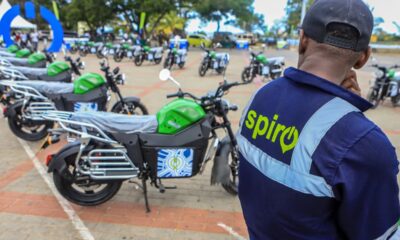
 Business5 days ago
Business5 days ago‘They’re Criminals,’ Popular Radio Presenter Rapcha The Sayantist Accuses Electric Bike Firm Spiro of Fraudulent Practices
-
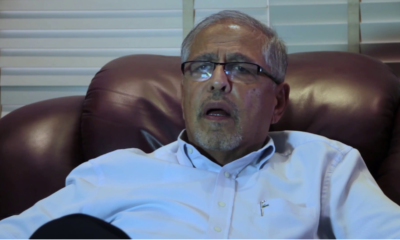
 News1 week ago
News1 week agoTemporary Reprieve As Mohamed Jaffer Wins Mombasa Land Compensation Despite Losing LPG Monopoly and Bitter Fallout With Johos
-

 Sports1 week ago
Sports1 week ago1Win Games 2025: Ultimate Overview of Popular Casino, Sports & Live Games
-
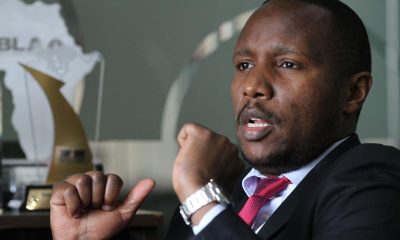
 Investigations1 week ago
Investigations1 week agoFrom Daily Bribes to Billions Frozen: The Jambopay Empire Crumbles as CEO Danson Muchemi’s Scandal-Plagued Past Catches Up
-
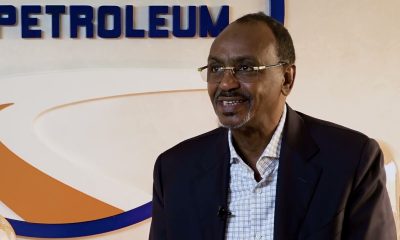
 Business1 week ago
Business1 week agoHass Petroleum Empire Faces Collapse as Court Greenlights KSh 1.2 Billion Property Auction
-
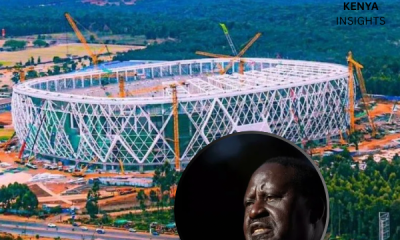
 Investigations5 days ago
Investigations5 days agoDisgraced Kuscco Boss Arnold Munene Moves To Gag Media After Expose Linking Him To Alleged Sh1.7 Billion Fraud
-
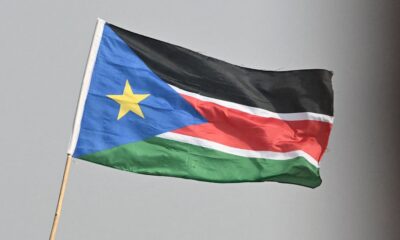
 Africa4 days ago
Africa4 days agoDisgraced Oil Trader Idris Taha Sneaks Into Juba as Empire Crumbles
-

 Investigations5 days ago
Investigations5 days agoFraud: How Sh235 Million Donor Cash For Nyamira Residents Was Embezzled Through Equity Bank Under Governor Nyaribo’s Watch

